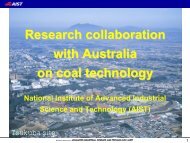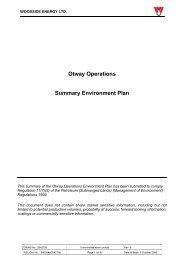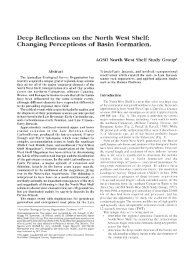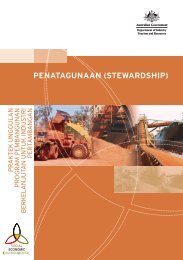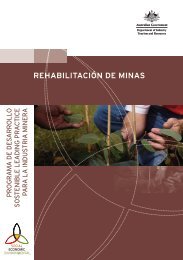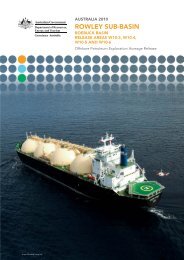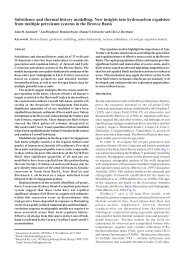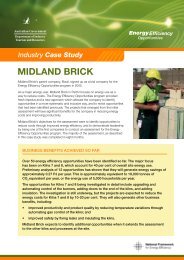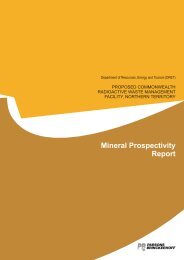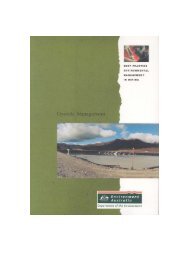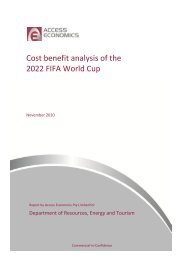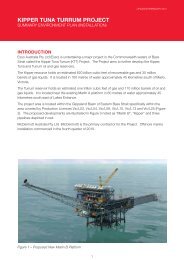A guide to leading practice sustainable development in mining
A guide to leading practice sustainable development in mining
A guide to leading practice sustainable development in mining
You also want an ePaper? Increase the reach of your titles
YUMPU automatically turns print PDFs into web optimized ePapers that Google loves.
An environmental and social impact assessment is conducted, <strong>to</strong><br />
enable regula<strong>to</strong>rs and other stakeholders <strong>to</strong> review predicted impacts<br />
and mitigation measures. It must be a transparent process based on<br />
both good science and extensive consultation, and conducted us<strong>in</strong>g an<br />
agreed risk management and <strong>susta<strong>in</strong>able</strong> <strong>development</strong> approach.<br />
Company risk management frameworks are def<strong>in</strong>ed <strong>to</strong> identify potentially<br />
‘significant’ risks so control measures can be developed and applied,<br />
and the success of their implementation can be evaluated.<br />
Internal company standards and procedures are applied <strong>to</strong> ensure<br />
the corporate objectives are clear and provide a m<strong>in</strong>imum standard<br />
of environmental protection for <strong>in</strong>dividual sites <strong>to</strong> atta<strong>in</strong>.<br />
Lead<strong>in</strong>g <strong>practice</strong> <strong>guide</strong>l<strong>in</strong>es from with<strong>in</strong> Australia and overseas<br />
(such as the International Council on M<strong>in</strong><strong>in</strong>g and Metals pr<strong>in</strong>ciples)<br />
provide case studies and frameworks for plann<strong>in</strong>g.<br />
Ongo<strong>in</strong>g moni<strong>to</strong>r<strong>in</strong>g programs are established, <strong>to</strong> assess real time and<br />
his<strong>to</strong>ric performance and, <strong>to</strong>gether with research programs, enable<br />
cont<strong>in</strong>uous improvement by provid<strong>in</strong>g <strong>in</strong>formation <strong>to</strong> <strong>guide</strong> future<br />
adjustments <strong>to</strong> environmental management and moni<strong>to</strong>r<strong>in</strong>g. Rigorous<br />
review of the data collected by a moni<strong>to</strong>r<strong>in</strong>g program, conducted at<br />
appropriate <strong>in</strong>tervals, is critical <strong>to</strong> ensure the moni<strong>to</strong>r<strong>in</strong>g program<br />
rema<strong>in</strong>s applicable and enables impacts <strong>to</strong> be measured.<br />
Recognis<strong>in</strong>g that every m<strong>in</strong><strong>in</strong>g project and community is different, research<br />
is conducted <strong>to</strong> address gaps <strong>in</strong> knowledge and develop <strong>in</strong>novative<br />
solutions <strong>to</strong> problems. Together with the feedback from moni<strong>to</strong>r<strong>in</strong>g, the<br />
<strong>in</strong>formation gathered through research l<strong>in</strong>ked <strong>to</strong> <strong>lead<strong>in</strong>g</strong> <strong>practice</strong> moni<strong>to</strong>r<strong>in</strong>g<br />
pr<strong>in</strong>ciples is a key element of the cont<strong>in</strong>uous improvement loop.<br />
Audits are used <strong>to</strong> evaluate compliance with regula<strong>to</strong>ry requirements,<br />
company standards and/or other adopted systems and procedures.<br />
This helps <strong>in</strong>dustry <strong>to</strong> demonstrate its performance <strong>to</strong> stakeholders<br />
and encourages cont<strong>in</strong>uous improvement. When audits of moni<strong>to</strong>r<strong>in</strong>g<br />
programs identify gaps <strong>in</strong> knowledge or <strong>in</strong>adequacies <strong>in</strong> control<br />
measures, they enable moni<strong>to</strong>r<strong>in</strong>g programs <strong>to</strong> be improved.<br />
Often, these elements are part of an environmental management system <strong>in</strong><br />
compliance with AS/NZS ISO 14001:2004 Environmental management systems—<br />
requirements with guidance for use. An environmental management system<br />
helps the company <strong>to</strong> achieve <strong>lead<strong>in</strong>g</strong> <strong>practice</strong> by provid<strong>in</strong>g a framework for the<br />
<strong>development</strong> and regular review of procedures used <strong>to</strong> assess, mitigate and manage<br />
environmental impacts.<br />
These elements are adapted <strong>to</strong> moni<strong>to</strong>r and audit the performance of brownfield sites,<br />
depend<strong>in</strong>g on the site and its context, <strong>in</strong>clud<strong>in</strong>g the physical and social aspects, the age<br />
of the m<strong>in</strong>e, key risks/issues and the his<strong>to</strong>rical evolution of the site and its ownership.<br />
A GUIDE TO LEADING PRACTICE SUSTAINABLE DEVELOPMENT IN MINING 75



